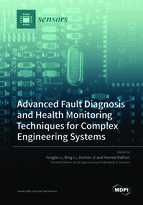Advanced Fault Diagnosis and Health Monitoring Techniques for Complex Engineering Systems
A special issue of Sensors (ISSN 1424-8220). This special issue belongs to the section "Fault Diagnosis & Sensors".
Deadline for manuscript submissions: closed (1 November 2022) | Viewed by 25965
Special Issue Editors
Interests: information fusion; digital twin technology; structural health monitoring; fault diagnosis and prognosis; system reliability analysis; dynamic modelling of mechanical systems
Special Issues, Collections and Topics in MDPI journals
Interests: structural health monitoring; elastic-wave and vibration control; wave mechanics; non-destructive testing; elastic/acoustic metamaterials
Special Issues, Collections and Topics in MDPI journals
Interests: dynamic modelling; vibration analysis; vibration control; fatigue analysis; stability analysis; FEM analysis; cooperative control of multi-agent systems
Special Issues, Collections and Topics in MDPI journals
2. Department of Mechanical Engineering, Faculty of Engineering, Bu-Ali Sina University, Hamedan 65167-38695, Iran
Interests: structural health monitoring; inverse problems; sensors and signal processing
Special Issues, Collections and Topics in MDPI journals
Special Issue Information
Dear Colleagues,
Over the last few decades, the field of fault diagnostics and structural health management has been experiencing rapid developments. The reliability, availability, and safety of engineering systems can be significantly improved by implementing multifaceted strategies of in situ diagnostics and prognostics. With the development of intelligence algorithms, smart sensors, and advanced data collection and modeling techniques, this challenging research area has been receiving ever-increasing attention in both fundamental research and engineering applications. This has been strongly supported by the extensive applications ranging from aerospace, automotive, transport, manufacturing, and processing industries to defense and infrastructure industry. In view of the current state of the art and advances in this fast-growing discipline, in this Special Issue, we are calling for papers related to all aspects of fault diagnostics, damage identification, and prognostics-based health management. A wide range of topics are covered, including new theories, methodologies, optimization, and applications in sensing, measurement, modeling, control, and prognostics. Topics include but are not limited to:
- Measuring techniques for condition monitoring;
- Reliability analysis and design;
- Signal processing of measured data;
- Feature extraction of measured data;
- Fault diagnosis for prognosis and health management (PHM);
- Degradation modeling of measured data;;
- Measurement error analysis;
- RUL prediction method based on intelligent algorithms;
- Maintenance strategy optimization;
- Structural health monitoring (SHM);
- Non-destructive testing (NDT).
Dr. Yongbo Li
Prof. Dr. Bing Li
Dr. Jinchen Ji
Dr. Hamed Kalhori
Guest Editors
Manuscript Submission Information
Manuscripts should be submitted online at www.mdpi.com by registering and logging in to this website. Once you are registered, click here to go to the submission form. Manuscripts can be submitted until the deadline. All submissions that pass pre-check are peer-reviewed. Accepted papers will be published continuously in the journal (as soon as accepted) and will be listed together on the special issue website. Research articles, review articles as well as short communications are invited. For planned papers, a title and short abstract (about 100 words) can be sent to the Editorial Office for announcement on this website.
Submitted manuscripts should not have been published previously, nor be under consideration for publication elsewhere (except conference proceedings papers). All manuscripts are thoroughly refereed through a single-blind peer-review process. A guide for authors and other relevant information for submission of manuscripts is available on the Instructions for Authors page. Sensors is an international peer-reviewed open access semimonthly journal published by MDPI.
Please visit the Instructions for Authors page before submitting a manuscript. The Article Processing Charge (APC) for publication in this open access journal is 2600 CHF (Swiss Francs). Submitted papers should be well formatted and use good English. Authors may use MDPI's English editing service prior to publication or during author revisions.










